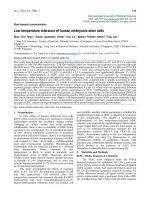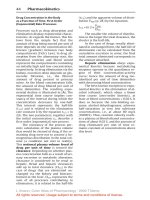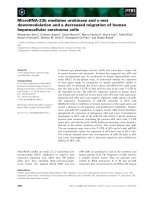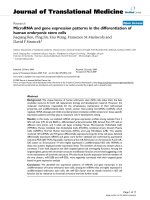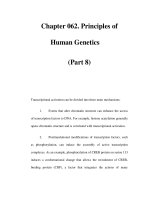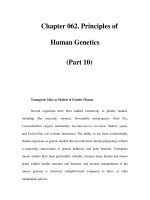Atlas of Human Pluripotent Stem Cells doc
Bạn đang xem bản rút gọn của tài liệu. Xem và tải ngay bản đầy đủ của tài liệu tại đây (11.02 MB, 157 trang )
Series Editor
Kursad Turksen, Ph.D.
Stem Cell Biology and Regenerative Medicine
For further volumes:
/>
Michal Amit
●
Joseph Itskovitz-Eldor
Atlas of Human Pluripotent
Stem Cells
Derivation and Culturing
With contributions by Ilana Laevsky, BA
and Atara Novak, MSc
Michal Amit, PhD
Department of Obstetrics and Gynecology
Rambam Health Care Campus
Stem Cell Research Center
Rapapport Faculty of Medicine
Technion – Israel Insitute of Technology
Haifa, Israel
Joseph Itskovitz-Eldor, MD DSc
Department of Obstetrics and Gynecology
Rambam Health Care Campus
Stem Cell Research Center
Rapapport Faculty of Medicine
Technion – Israel Insitute of Technology
Haifa, Israel
ISBN 978-1-61779-547-3 e-ISBN 978-1-61779-548-0
DOI 10.1007/978-1-61779-548-0
Springer New York Dordrecht Heidelberg London
Library of Congress Control Number: 2011941608
© Springer Science+Business Media, LLC 2012
All rights reserved. This work may not be translated or copied in whole or in part without the written
permission of the publisher (Humana Press, c/o Springer Science+Business Media, LLC, 233 Spring Street,
New York, NY 10013, USA), except for brief excerpts in connection with reviews or scholarly analysis.
Use in connection with any form of information storage and retrieval, electronic adaptation, computer
software, or by similar or dissimilar methodology now known or hereafter developed is forbidden.
The use in this publication of trade names, trademarks, service marks, and similar terms, even if they are
not identifi ed as such, is not to be taken as an expression of opinion as to whether or not they are subject
to proprietary rights.
Printed on acid-free paper
Humana Press is part of Springer Science+Business Media (www.springer.com)
v
We are very pleased to present this Atlas on Human Pluripotent Stem Cells —
Derivation and Culturing , summarizing 12 years of our team’s experience, skill
and knowledge in the derivation, culture and expansion of human embryonic stem
cells, and more recently, of human induced pluripotent stem cells. The exploration
and realization of the incredible potential of these pluripotent stem cells for study-
ing the fundamentals of early human development and organogenesis, for cell-
based therapy and for disease modeling in the dish are a key focus of current
biomedical research. Although murine embryonic stem cells have been used in
research for 4 decades, techniques established for their growth have proven less
amenable for long-term culture, expansion and manipulation of human pluripotent
stem cells.
The culmination of two events has enabled the production of human embryonic
stem cells: the birth of the fi rst IVF test-tube baby in 1978 (Steptoe and Edwards
1978) and the discovery in 1981 by Martin (1981) and Evans and Kaufman (1981) of
mouse embryonic stem cells. Later, development of sequential media in the mid-
1990s enabled the growth of fertilized oocytes to viable blastocysts, from which the
inner cell mass was extracted and human embryonic stem cells derived. These break-
throughs paved the way to the derivation of the fi rst fi ve human embryonic stem cell
lines by Thomson et al. in Madison, Wisconsin, 1998 (Thomson et al. 1998). More
recently, Yamanaka and team enthused the scientifi c community with their publica-
tion on the reprogramming of adult skin fi broblasts into induced pluripotent stem
cells (Takahashi and Yamanaka, 2006).
To realize the full potential of embryonic and induced pluripotent stem cells,
technologies, and especially those related to stem cell-based therapies, must achieve
controlled cell growth in defi ned conditions for prolonged time periods, while main-
taining cell stability, i.e., minimal genetic abnormalities, pluripotency and differen-
tiation potential. For stem cell-based therapies and screening, robust production of
cells in controlled dynamic cultures (bioreactors) is required. To that end, methods
for expansion of pluripotent stem cells in non-adherent conditions, i.e., in suspen-
sion, are emerging.
Preface
vi
Preface
This atlas provides up-to-date techniques that will be useful to those currently
active in basic as well as translational research in the fi eld of embryonic and induced
pluripotent stem cells. It commences with practical aspects of the derivation and
growth of human embryonic stem cells from inner cell mass blastocyst stage
embryos. Three chapters in this volume deal with cell culture techniques, presenting
the protocols and morphology of cells cultured on mouse embryonic fi broblasts and
on foreskin fi broblasts, and the culturing of cells in feeder-free conditions. Taken
together, the information provided in these chapters will enable the culture of pluri-
potent stem cells in defi ned conditions that are animal product-free, serum-free and
feeder-free. The subsequent chapter describes the transformation of cell growth
from adhesion to non-adhesion cultures, laying the foundation for the development
of a system for robust therapeutic and industrial modalities.
The pluripotency and differentiation potential of human pluripotent stem cells
are examined and described in the two chapters that focus on the differentiation of
the cells into embryoid bodies in vitro and teratoma formation in vivo. The differ-
entiation by immunostaining of undifferentiated and early differentiated human
pluripotent stem cells is demonstrated in the subsequent chapter. Karyotype stability
of human pluripotent stem cells is sensitive to growth conditions and to the manner
in which cells are handled. This important issue is discussed in another chapter
describing the common principles of karyotyping and fl uorescent in situ hybridization
(FISH) methods as they apply to the fi eld of pluripotent stem cells.
Induced pluripotent stem cells attract great interest for their potential in under-
standing the basics of cell reprogramming, personalized medicine and disease
modeling—a topic that concludes this atlas. In this last chapter the method for the
derivation of human induced pluripotent stem cells from hair follicle keratinocytes
is described.
We hope that this concise yet comprehensive atlas becomes a reference and an
encyclopedia for young as well as established researchers, students and other indi-
viduals, involved in the fi eld of stem cells. It is also our hope that the methods,
descriptions and images provided in this atlas facilitate the realization of the enor-
mous potential of human pluripotent stem cells and shorten the path from the bench
to the bedside.
We are grateful for the generous support of the Technion’s Stem Cell Center by
the Sohnis and Forman Families. We thank Ilana Laevsky and Atara Novak for their
valuable contributions. The cooperation and enthusiasm shown by the staff mem-
bers at Springer who were involved in the accomplishment of this project are greatly
appreciated. Special thanks are extended to all the members of our laboratory who
contributed during the past decade to the research presented in this book.
Haifa, Israel Michal Amit, PhD
Joseph Itskovitz-Eldor, MD DSc
vii
Preface
References
Evans MJ, Kaufman MH (1981) Establishment in culture of pluripotential cells from mouse
embryos. Nature 292(5819):154–156
Martin GR (1981) Isolation of a pluripotent cell line from early mouse embryos cultured in medium
conditioned by teratocarcinoma stem cells. Proc Natl Acad Sci U S A 78(12):7634–7638
Steptoe PC, Edwards RG (1978) Birth after the reimplantation of a human embryo. Lancet
2(8085):366
Takahashi K, Yamanaka S (2006) Induction of pluripotent stem cells from mouse embryonic and
adult fi broblast cultures by defi ned factors. Cell 126(4):663–676
Thomson JA, Itskovitz-Eldor J, Shapiro SS, Waknitz MA, Swiergiel JJ, Marshall VS, Jones JM
(1998) Embryonic stem cell lines derived from human blastocysts. Science 282(5391):
1145–1147
ix
1 Methods for the Derivation of Human Embryonic
Stem Cell Lines 1
1.1 Introduction 1
1.2 Materials for ESC Line Derivation 9
1.3 Methods for hESC Isolation 9
1.3.1 hESC Isolation by Immunosurgery 12
1.3.2 Mechanical Removal of Trophectoderm 12
1.3.3 Whole Embryo Approach for ESC Line Derivation 13
References 13
2 Morphology of Human Embryonic and Induced Pluripotent
Stem Cell Colonies Cultured with Feeders 15
2.1 Introduction 15
2.2 Materials 16
2.2.1 For Mouse Embryonic Fibroblasts (MEFs)
and Foreskin Fibroblasts (HFFs) 16
2.2.2 For hPSC Maintenance 17
2.3 Methods 18
2.3.1 Feeder Culture Methods 18
2.3.2 hPSC Culture 22
References 38
3 Morphology of Human Embryonic Stem Cells and Induced
Pluripotent Stem Cells Cultured in Feeder
Layer-Free Conditions 41
3.1 Introduction 41
3.2 Materials for Feeder Layer-Free Culture of hPSCs 43
3.2.1 Matrix Preparation 43
3.2.2 Culture Medium 44
Contents
x
Contents
3.3 Methods for hPSC Feeder Layer-Free Culture 44
3.3.1 Preparation of Matrix-Covered Plates 44
3.3.2 Splitting, Freezing, and Thawing hPSCs 45
3.3.3 Adaptation of PSCs to Feeder-Free Culture 45
3.3.4 Routine Culture of hPSCs 46
References 54
4 Morphology of Undifferentiated Human Embryonic
and Induced Stem Cells Grown in Suspension
and in Dynamic Cultures 57
4.1 Introduction 57
4.2 Materials for Suspension Culture of hPSCs 58
4.2.1 Culture Medium 58
4.2.2 Splitting Medium 59
4.2.3 Freezing Medium 59
4.3 Methods for Suspension Culture of hPSCs 60
4.3.1 Creating a hPSC Suspension Culture 60
4.3.2 Splitting hPSCs in Suspension 60
4.3.3 Freezing hPSCs in Suspension 62
4.3.4 Thawing hPSCs in Suspension 64
4.3.5 Culturing hPSCs in a Dynamic System 64
4.3.6 Routine Culture of hPSCs in Suspension 65
References 71
5 Differentiation of Pluripotent Stem Cells In Vitro:
Embryoid Bodies 73
5.1 Introduction 73
5.2 Materials for EB Formation 75
5.2.1 Culture Medium Supplemented with Serum 75
5.2.2 Splitting Medium Based on Collagenase 76
5.3 Methods for EB Formation and Culture 76
5.3.1 EB Formation 76
5.3.2 Routine Culture of EBs 76
5.3.3 Culturing EBs in Spinner Flasks 78
References 88
6 Differentiation of Pluripotent Stem Cells In Vivo:
Teratoma Formation 91
6.1 Introduction 91
6.2 Materials for Teratoma Formation 93
6.2.1 Culture Medium 93
6.2.2 Syringe for Injecting Cells 93
6.3 Formation of Teratomas 93
6.3.1 Protocol for Teratoma Formation 93
6.3.2 Routine Treatment of Mice and Teratoma 93
References 103
xi
Contents
7 Immunostaining 105
7.1 Introduction 105
7.2 Materials and Solutions for Immunostaining 111
7.2.1 Materials and Solutions for Immunohistochemistry
of Paraffi n-Embedded Tissues 111
7.2.2 Materials and Solutions for Immunofl uorescence 111
7.3 Immunostaining Procedures 112
7.3.1 Immunohistochemistry of Paraffi n-Embedded Tissues 112
7.3.2 Immunofl uorescence of Cultured Cells 113
References 113
8 Karyotype and Fluorescent In Situ Hybridization
Analysis of Human Embryonic Stem Cell and Induced
Pluripotent Stem Cell Lines 115
8.1 Introduction 115
8.1.1 Karyotype Analysis 115
8.1.2 FISH Analysis 121
8.2 Materials for Harvesting Cells for Karyotyping
and FISH Analysis 124
8.2.1 Reagents 124
8.2.2 Solutions 124
8.3 Procedure of Harvesting Cells for Karyotyping
and FISH Analysis 124
References 126
9 Method for the Derivation of Induced Pluripotent
Stem Cells from Human Hair Follicle Keratinocytes 127
9.1 Introduction 127
9.2 Materials 129
9.2.1 NIH-3T3/293T Cells 129
9.2.2 Keratinocyte Derivation from Plucked Hair Follicles 129
9.3 Methods 130
9.3.1 NIH-3T3 and 293T Culture Methods 130
9.3.2 Keratinocyte Culture Methods 132
9.3.3 Preparation of the STEMCCA Virus for Infection 133
9.3.4 Derivation of iPSCs from Hair Keratinocytes 134
References 137
About the Authors 139
Index 141
xiii
List of Abbreviations
bFGF Basic fi broblast growth factor
Bio Glycogen synthase kinase-3 specifi c inhibitor
C.R.A. Chromosome resolution additive
DAPI 4 ¢ ,6-diamidino-2-phenylindole
DMEM Dulbecco’s modifi ed Eagle’s medium
DMSO Dimethyl sulfoxide
DNA Deoxyribonucleic acid
EBs Embryoid bodies
EGF Epidermal growth factor
FBS Fetal bovine serum
FISH Fluorescent in situ hybridization
FITC Fluorescein isothiocyanate
GSK-3 Glycogen synthase kinase-3
H&E Hematoxylin and eosin
hESCs Human embryonic stem cells
HFF Foreskin fi broblasts
HRP Horseradish peroxidase
ICM Inner cell mass
ICR Imprinting control region mice
IHC Immunohistochemistry
IF Immunofl uorescence
IRS Inner root sheath
iPSCs Induced pluripotent stem cells
ISCN International system for human cytogenetic nomenclature
IVF In vitro fertilization
KO Knockout
xiv
List of Abbreviations
LIF Leukemia inhibitory factor
MEFs Mouse embryonic fi broblasts
NGS Normal goat serum
NOR Nucleolus organizer regions
ORS Outer root sheath
PBS Phosphate buffer saline
PGD Pre-implantation genetic diagnosis
ROCK Rho kinase inhibitor Y-27632
SCID Severe combined immunodefi ciency
SR Serum replacement
STR Stirred tank bioreactor
TRDF Technion Research and Development Foundation
TGF b 1 Transforming growth factor beta 1
VEGF-A165 Vascular endothelial growth factor A (VEGF-A165)
ZP Zona pellucida
1
M. Amit and J. Itskovitz-Eldor, Atlas of Human Pluripotent Stem Cells:
Derivation and Culturing, Stem Cell Biology and Regenerative Medicine,
DOI 10.1007/978-1-61779-548-0_1, © Springer Science+Business Media, LLC 2012
Abstract Human embryonic stem cells (hESCs) are pluripotent cells derived from
the inner cell mass (ICM) of the developing embryo. They have tremendous poten-
tial for the research of early human development, differentiation processes, and
teratology, as well as for industrial and clinical purposes, such as drug screening and
cell-based therapy. Since hESCs were fi rst derived by Thomson and his colleagues
in 1998, considerable effort has been invested to improve methods of isolating new
lines, in defi ned conditions, and to increase success rates. This chapter discusses the
most commonly used methods for deriving hESC lines, including immunosurgery
and the whole embryo approach.
1.1 Introduction
Human embryonic stem cell (hESC) lines, like those from other species, are
pluripotent cell lines derived from the inner cell mass (ICM) of the developing
embryo. Due to their exceptional capability of proliferating indefi nitely as undif-
ferentiated cells when cultured in appropriate conditions, and of sustaining a normal
karyotype, hESCs may have broad applications for industrial uses; clinical pur-
poses, namely, cell-based therapy; and research of early human development,
differentiation mechanisms, and lineage commitment.
The fi rst ESC lines were derived from mouse embryos in 1981 (Evans and
Kaufman 1981 ; Martin 1981 ) . Bongso and colleagues later demonstrated that
ESC-like cells can be isolated from human embryos. They described the isolation
of ICM cells from human blastocysts and the culturing of these cells for two pas-
sages, while expressing alkaline phosphate activity and demonstrating ESC-like
morphology (Bongso et al. 1994 ) . In 1998, Thomson and his colleagues presented
the fi rst fi ve hESC lines (Thomson et al. 1998 ) . The lack of a source of high-quality
human blastocysts accounts in large part for the long time lapse between the deri-
vation of ESC lines from mouse embryo and the derivation of human lines using
basically the same culturing techniques.
Chapter 1
Methods for the Derivation of Human
Embryonic Stem Cell Lines
2
1 hESCs Derivation
The fi rst successful in vitro fertilization (IVF), based on retrieval of a single
embryo from an oocyte developed in a spontaneous menstrual cycle, was reported
in 1978 by the pioneering study of Steptoe and Edwards ( 1978 ) . The technique of
controlled ovarian hyperstimulation has since achieved several retrieved oocytes per
cycle. In addition, the in vitro culturing of human embryos to the blastocyst stage
has progressed greatly. The main source of human embryos for research purposes
has thus become surplus IVF embryos (Thomson et al. 1998 ; Reubinoff et al. 2000 ;
Amit and Itskovitz 2002 ; Cowan et al. 2004 ) , as well as discarded low-quality
embryos (Mitalipova et al. 2003 ; Lerou et al. 2008 ) , abnormally fertilized zygotes,
and discarded genetically abnormal embryos after pre-implantation genetic diagno-
sis (PGD) (Verlinsky et al. 2005 ; Mateizel et al. 2006 ; Amit and Itskovitz-Eldor,
unpublished data). Only one documented study used embryos that were produced
specifi cally for research purposes (Lanzendorf et al. 2001 ) . Examples of human
blastocyst morphology are illustrated in Fig. 1.1 .
Similar to the methods used for the derivation of mouse ESCs, most hESC lines
have been derived using supporting layers, mainly of mouse embryonic fi broblasts
(MEFs) (Thomson et al. 1998 ; Reubinoff et al. 2000 ; Amit and Itskovitz-Eldor 2002 ;
Cowan et al. 2004 ; Verlinsky et al. 2005 ) . Klimanskaya and his colleagues fi rst reported
the feeder layer-free isolation of hESC lines. Using serum-free medium and MEF-
produced matrix, they successfully generated six new hESC lines that exhibited ESC
features after prolonged culture (Klimanskaya et al. 2005 ) . This pioneering study
Fig. 1.1 Examples of human blastocyst morphology. ( a ) Five-day-old embryo in which the tro-
phoplast extends through a hole drilled in the zona pellucida (ZP). No inner cell mass (ICM) can
be recognized. ( b ) Six-day-old pseudo-blastocyst in which the trophoplast extends through a hole
drilled for pre-implantation genetic diagnosis (PGD). No ICM can be recognized. ( c–f ) Six-day-
old blastocysts with clear ICM. ICM is marked with white arrows . ( a–c ) Bar 50 m M, ( d–f ) Bar
30 m M
3
1.1 Introduction
demonstrates the feasibility of feeder layer-free derivation of hESCs. A recent publi-
cation by Ludwig and colleagues reported the derivation of two new hESC lines using
a defi ned serum-free and animal-free medium, and feeder layer-free culture conditions
(Ludwig et al. 2006 ) . The matrix used consisted of human collagen, fi bronectin, and
laminin. The two newly derived cell lines sustained most hESC features after several
months of continuous culture. However, both lines were reported to harbor karyotype
abnormalities. It has yet to be determined whether the embryos were originally
defected or whether the abnormalities detected are due to the method implemented.
ESC lines are traditionally isolated from blastocysts using immunosurgery, a
straightforward method developed by Solter and Knowles during the 1970s for sep-
arating between the trophoectoderm layer and the ICM (Solter and Knowles 1975 ) .
This achieved, and following removal of the zona pellucida (ZP) (Fig. 1.2 ), the
Fig. 1.2 Zona Pellucida removal with Tyrode’s acid. ( a ) Six-day-old embryo with notable ICM
(marked with white arrow ) before ZP removal. ( b ) The same embryo after ZP removal. The ICM
cannot be clearly distinguished. ( c ) Six-day-old blastocysts after ZP removal, with the ICM loca-
tion clearly visible (marked with white arrow ). ( d ) Six-day-old blastocyst after ZP was removed.
A residue of the ZP is noted ( black arrow ). The ZP residue might affect the capability of the
embryo to attach to the feeder layer. The ZP piece should be removed mechanically (enzymes or
Tyrode’s acid might harm the exposed embryo). ( a , b ) Bar 40 m M, ( c , d ) Bar 70 m M
4
1 hESCs Derivation
embryo is exposed to antihuman whole serum antibodies, which attach to any
human cell. Cell–cell connections within the outer layer of the trophoblast prevent
penetration of the antibodies into the blastocyst, thus leaving the ICM cells intact.
Incubation with guinea pig complement-containing medium then lyses all antibody-
marked cells. The intact ICM is further rinsed and cultured with mitotically inacti-
vated MEFs or an alternative feeder layer that supports hESC culture. The ICM can
also be isolated mechanically by removing the trophectoderm layer, using either
25–27 gauge needles or pulled Puster pipettes under a dissecting microscope. As with
immunosurgery, the isolated ICM is then cultured with a supporting layer. The
steps of immunosurgery are depicted in Fig. 1.3 . Following immunosurgery, ICM
cells are cultured and allowed to proliferate, with MEFs serving as supporting layers.
Although ICM cells can be split using trypsin or other enzymes (Cowan et al. 2004 ) ,
higher survival rates may be achieved from mechanical splitting methods. The mor-
phology of the colonies resulting from ICM growth and mechanical splitting is
illustrated in Figs. 1.4 – 1.7 .
Alternatively, ESC lines can be derived without the removal of the trophectoderm,
by plating exposed embryos as a whole with a supporting layer, as illustrated in
Figs. 1.8 – 1.10 . The blastocyst, which is attached to the feeder layer, continues to
grow with the surrounding trophoblast. When the ICM reaches suffi cient size, it is
selectively removed and propagated. ICM outgrowth within blastocysts plated
Fig. 1.3 Immunosurgery method. ( a ) Exposed embryo during incubation with antihuman whole
serum antibodies. The ICM location is not clear; the trophectoderm morphology is distinguishable,
as elongated cells. Bar 60 m M. ( b ) Two exposed embryos during incubation with antibodies; ICM
is clearly noted ( white arrows ). Bar 30 m M. ( c ) Exposed embryo during incubation with guinea pig
complement. The blastocoele is still notable. Bar 45 m M. ( d ) Exposed embryo at the end of incuba-
tion with guinea pig complement; ghost cells after lysis can be seen ( black arrow ). Bar 20 m M.
( e , f ) Examples of ICM attached to the mouse embryonic fi broblast (MEF) supportive layer 24 h
post-plating. Bar 60 m M
5
1.1 Introduction
Fig. 1.4 Plated ICM. ( a ) ICM plated on MEFs 24 h post-plating. The ICM still resembles clumps
of cells with no colony formation. Bar 50 m M. ( b–d ) ICM plated on MEFs 3 days post-plating. A
colony was formed containing small round cells. Bar 20 m M, 90 m M for ( b ) and for ( c , d ),
respectively
Fig. 1.5 Mechanical splitting. Examples of colony morphology 24 h post-mechanical splitting of
the ICM and plating on MEFs. The cells are at passage 2. ( a ) Clear borders between MEFs and
embryonic stem cells (ESCs) were formed, while in ( b ) and ( c ) the colonies were still disorga-
nized. Bar 60 m M
6
1 hESCs Derivation
Fig. 1.8 Whole embryo approach for derivation of ESC lines. Exposed embryos plated on MEFs
12 h post-plating. In both embryos ( a ) and ( b ), the ICM is still recognized ( black arrows ) within
the attached embryo, which still contains a cavity. Bar 60 m M and 40 m M for ( a ) and ( b ),
respectively
Fig. 1.7 Passage 2. Examples of colony morphology 4 days post-mechanical splitting of the ICM
and plating on MEFs. The cells are at passage 2 post-derivation. All examples ( a–c ) demonstrate
colony formation, outgrowth, and ESC typical morphology of small cells with large nuclei, notable
nucleoli ( white arrow ), and spaces between cells. Bar 90 m M
Fig. 1.6 Passage 2. Examples of colony morphology 3 days post-mechanical splitting of the ICM
and plating on MEFs. The cells are at passage 2 post-derivation. All examples ( a–c ) demonstrate
colony formation with borders between MEFs and ESCs, and outgrowth. In ( a ), the spaces between
cells can be seen. Bar 60 m M
7
1.1 Introduction
whole is demonstrated in Fig. 1.11 . However, success rates in deriving hESC lines
are lower with the whole embryo approach, and some ICM colonies differentiate
(Figs. 1.12 and 1.13 ). Nevertheless, an advantage of the whole embryo approach is
isolation of hESC lines without the use of animal products (antibodies). Figure 1.14
demonstrates derivation of the ESC line, CL1, using animal-free medium
(NutriStem™, Biological Industries Ltd), human foreskin fi broblasts as feeder lay-
ers, and the whole embryo approach as the derivation method (Amit et al., unpub-
lished data).
The increasing number of hESC lines attests to the fact that their isolation is a
reproducible procedure with reasonable success rates.
Fig. 1.10 Whole embryo approach for derivation of ESC lines—partial embryo attachment.
Exposed embryo plated on MEFs 12 h post-plating. The embryo is only partly attached. The ICM
cannot be located. ( a ) Close-up of the attached part of the embryo ( black arrow ). ( b ) Focus on the
unattached trophoblasts ( black arrow ). Bar 50 m M
Fig. 1.9 Whole embryo approach for derivation of ESC lines. ( a ) Embryo before ZP removal. Due
to the drill in ZP, a large part of the embryo hatched from the ZP. Therefore, the ZP was removed
mechanically to avoid damage to the embryo that would be incurred by the use of Tyrode’s acid or
enzyme. ( b ) The exposed embryo plated on MEFs still has the same shape as when covered by the
ZP. Bar 50 m M and 80 m M for ( a ) and ( b ), respectively
8
1 hESCs Derivation
Fig. 1.11 Whole embryo approach for derivation of ESC lines—clear ICM outgrowth. ( a–c )
Three examples of plated embryos in which the ICM outgrowth can be clearly noted (marked with
circle ). Bar 90 m M
9
1.3 Methods for hESC Isolation
1.2 Materials for ESC Line Derivation
1.2.1 Tyrode’s acid (Sigma, acidic, C.N. T-1788).
1.2.2 Antibodies: antihuman whole antiserum (Sigma, H-8765), recommended
dilution 1:30 in Dulbecco’s modifi ed Eagle’s medium (DMEM).
1.2.3 Complement proteins: Guinea pig complement diluted 1:10 in DMEM or the
solvent provided by the supplier (Gibco BRL C.N. 10723-013).
1.2.4 hESC—serum-based medium: 80% DMEM\F12 (DMEM, Invitrogen
Corporation C.N. 10829018), 20% fetal bovine serum (FBS) (HyClone), 1%
nonessential amino acid, 1 mM l -glutamine, and 0.1 mM b -mercaptoethanol.
1.2.5 hESCs—serum-free medium: hESCs can be cultured with MEFs using the
following serum-free medium: 85% DMEM\F12, 15% SR (Invitrogen
Corporation knockout serum replacement C.N. 10828028), 1% nonessential
amino acid, 1 mM l -glutamine, 0.1 mM b -mercaptoethanol, and 4 ng/ml
basic fi broblast growth factor (bFGF).
1.3 Methods for hESC Isolation
Surplus embryo should be cultured to the blastocyst stage (day 5–6 postfertilization)
by a trained embryologist.
Fig. 1.12 Whole embryo approach for derivation of ESC lines on MEF—differentiation ( a , b ).
Two examples of plated embryos with ICM differentiation, the derivation failed. Bar 70 m M and
60 m M for ( a ) and ( b ), respectively
Fig. 1.13 Whole embryo approach for derivation of ESC lines on human foreskin fi broblasts—
differentiation. ( a – c ) Failed derivation. Three examples of differentiated ICM from embryos plated
on human foreskin fi broblasts. ( a ) The plated embryo resembles a colony. Since a whole embryo
was plated and there is no difference between trophoblast and ICM cells, the whole colony will
likely differentiate in a few days. ( b , c ) Clear differentiation of the plated embryo cells. Bar 60 m M
and 80 m M for ( a ) and ( b , c ), respectively
